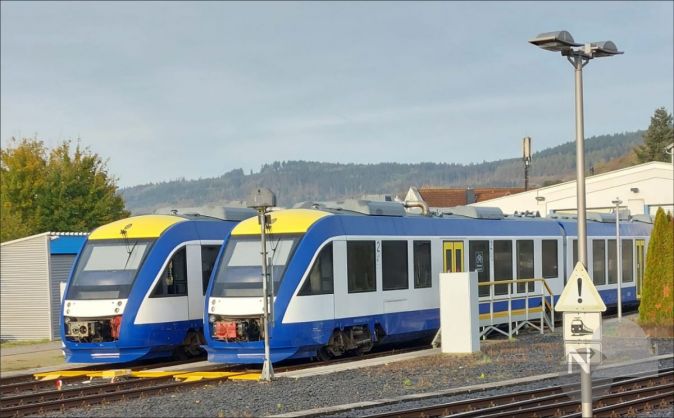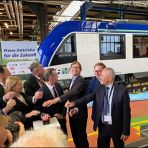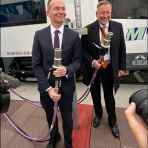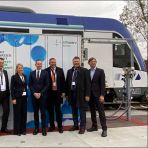Königstein
(gs) – Shortly before Christmas, a turning point in traffic technology was initiated in the Rhine-Main area – representative for the whole of Germany. On 11 December, the world‘s largest fleet of passenger trains was launched in the network of the Rhein Main transport association, featuring groundbreaking hydrogen fuel cell drive technology.
Königstein starts in spring
In Königstein, however, it will take a while until the new trains are used. If the first trains are used on the RB15 route (Frankfurt – Brandoberndorf), users of the other three routes in the Taunus network (RB11 Frankfurt-Höchst – Bad Soden, RB12 Frankfurt – Königstein and RB16 Bad Homburg – Friedberg) will have to wait until June 2023 at the latest to enjoy this modern train technology, because only then the manufacturer Alstom will have delivered all trains and „put them on the rails“.
Presentation with test drive
In November, the official unveiling of the first train took place on the premises of Deutsche Bahn AG in Frankfurt-Griesheim in the presence of Dr. Volker Wissing, Federal Minister for Digital Affairs and Transport. In future, the trains will be presented in noble white, with blue stripes and are decorated with water molecules – but those who have been lucky in recent weeks have already been able to admire live two of the drive cars that were „parked“ in the Königsteiner train station.
The first test drive took place at Industriepark Höchst, where Infraserv Höchst will operate the necessary hydrogen filling station in future.
Milestone in climate policy
Federal Minister Volker Wissing was convinced that emissions from transport must be significantly reduced to achieve the desired climate targets. According to Wissing, this means that Germany needs new, efficient, emission-free mobility and overall more energy systems that do not emit CO2 – hydrogen will play a major role in the implementation of this claim. Thanks to H2 technology, it will be possible to travel climate-neutral and significantly quieter in the (rail) networks in the future. This view was also shared by Ulrich Krebs, district administrator of the Hochtaunskreis. He was particularly pleased that the Taunus was chosen as part of this innovative lighthouse project.
The future is just around the corner
Evelyn Palla, Member of the Board of Management of Regional Transport DB Group, noted that the railway is sending „fossil fuels to the siding“. To make regional transport emission-free, hydrogen is being used as a technology of the future.
The federal government is funding the project with a total of 24.3 million euros (purchase of the trains and hydrogen filling station), the state of Hesse is funding the rail connection of the hydrogen filling station and a mobile train refuelling facility with 3.3 million euros. The trains can cover more than 1,200 kilometres when fully fuelled, making them more energy-efficient than previous diesel trains.
Fuel station at Industry Park Höchst
The fact that the largest hydrogen fleet will be on the road in the Rhine-Main region is not necessarily a coincidence, because in addition to the „lighthouse function“ of Frankfurt as a business location, the decisive factor was the fact that Infraserv at Industry Park Höchst is an experienced supplier of hydrogen for refuelling trains practically „on site“. „We are proud that Industriepark Höchst is an important part of this project as the site of the new hydrogen infrastructure to supply trains,“ said Joachim Kreysing, Managing Director of Infraserv Höchst.
In addition to the refueling facilities, the operating company of the industrial park has built additional hydrogen storage and compressor systems and expanded the track systems to be prepared for the future of hydrogen propulsion.
Four lines through the Taunus
From December, the first vehicles of the fleet of 27 trains started in the Taunus network and will initially be used on the RB15 line. The other trains will be successively delivered by Alstom until spring and gradually put into operation. They will then run on the previously (partially) non-electrified routes of the RB11, RB12, RB15 and RB16. The lines are operated by Regionalverkehre Start Deutschland GmbH (start). The 100% subsidiary of Deutsche Bahn already operates two corresponding networks in northern Germany and replaced the previous operator, Hessische Landesbahn GmbH (HLB), in December.
Transitional arrangements
To ensure operation until all hydrogen trains are fully delivered, HLB will – in the interests of passengers – continue to operate the RB11 and RB16 lines on a transitional basis until the end of April. Diesel-powered rental trains will continue to run on line RB12 (Frankfurt – Königstein) until the new hydrogen trains have arrived and been put into operation.
Modern and quiet
This suggests that line RB12 will be the next route on which the modern trains will be used, which is why the people of Königstein will also be able to enjoy the state-of-the-art trains with excellent equipment and more space for passengers.
The rumbling and rattling of the old cars will then be history, because in the new cars you literally glide along - without rumbling - and very, very much quieter.
The exciting moment of „unveiling“



